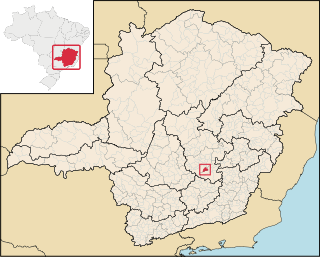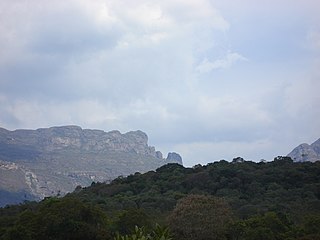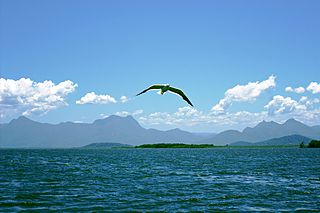
Belo Horizonte is the sixth-largest city in Brazil, with a population around 2.7 million and with a metropolitan area of 6 million people. It is the 13th-largest city in South America and the 18th-largest in the Americas. The metropolis is anchor to the Belo Horizonte metropolitan area, ranked as the third-most populous metropolitan area in Brazil and the 17th-most populous in the Americas. Belo Horizonte is the capital of the state of Minas Gerais, Brazil's second-most populous state. It is the first planned modern city in Brazil.

Minas Gerais is a state in Southeastern Brazil. It ranks as the second most populous, the third by gross domestic product (GDP), and the fourth largest by area in the country. The state's capital and largest city, Belo Horizonte, is a major urban and finance center in Latin America, and the sixth largest municipality in Brazil, after the cities of São Paulo, Rio de Janeiro, Salvador, Brasília and Fortaleza, but its metropolitan area is the third largest in Brazil with just over 5,800,000 inhabitants, after those of São Paulo and Rio de Janeiro. Nine Brazilian presidents were born in Minas Gerais, the most of any state. The state has 10.1% of the Brazilian population and is responsible for 8.7% of the Brazilian GDP.

Ouro Preto, formerly Vila Rica, is a city in and former capital of the state of Minas Gerais, Brazil, a former colonial mining town located in the Serra do Espinhaço mountains and designated a World Heritage Site by UNESCO because of its outstanding Baroque Portuguese colonial architecture.

Santa Bárbara is a Brazilian municipality founded in 1704 and located in the state of Minas Gerais.

Nova Lima is a municipality of about 87,000 people, whose downtown is located about 20 kilometers south of Belo Horizonte, the capital of the south-eastern Brazilian state of Minas Gerais. Mining is one of the main economical activities of the city, including the extraction of Iron Ore and Gold. The most famous mine in the city is Morro Velho, a gold mine of 2,700 metres (8,900 ft) depth.
Morro Velho, also called AngloGold Ashanti Brasil Mineração, after its current owner AngloGold Ashanti, is a complex of gold mines located near the city of Nova Lima in the Minas Gerais state of Brazil.

Itabirito is a municipality in the Minas Gerais state of Brazil. Its population is estimated to have 52,446 people in 2020. The city belongs to the mesoregion Metropolitan of Belo Horizonte and to the microregion of Ouro Preto.

Caeté is a Brazilian municipality located in the state of Minas Gerais. The city belongs to the mesoregion Metropolitana de Belo Horizonte and to the microregion of Belo Horizonte.

Itabira is a Brazilian municipality and a major city in the state of Minas Gerais. The city belongs to the Belo Horizonte metropolitan area mesoregion and to the Itabira microregion.

Ibirité is a Brazilian municipality located in the state of Minas Gerais. The city belongs to the mesoregion Metropolitana de Belo Horizonte and to the microregion of Belo Horizonte. Its population in 2020 was 182,153.
Mining in Brazil is centered on the extraction of iron, copper, gold, aluminum, manganese, tin, niobium, and nickel. About gemstones, Brazil is the world's largest producer of amethyst, topaz, agate and is a big producer of tourmaline, emerald, aquamarine, garnet and opal.

Baependi is a Brazilian municipality located in the state of Minas Gerais.

Barão de Cocais is a Brazilian municipality located in the state of Minas Gerais. Its population as of 2020 is estimated to be 32,866 people living in an altitude between 682 and 1425 meters. The area of the municipality is 340.675 square kilometres (131.535 sq mi). The city belongs to the mesoregion Metropolitana de Belo Horizonte and to the microregion of Itabira.

Brumadinho is a Brazilian municipality in the state of Minas Gerais. The city belongs to the Belo Horizonte metropolitan mesoregion and to the microregion of Belo Horizonte. Brumadinho is at an altitude of 880 m. In 2020 the population was 40,666. The municipality is on the Paraopeba River.

Rio Acima is a Brazilian municipality located in the state of Minas Gerais. The city belongs to the mesoregion Metropolitana de Belo Horizonte and to the microregion of Belo Horizonte. As of 2020, the estimated population was 10,420.

The das Velhas River is by length the major tributary of the basin of the São Francisco river. Its water flows into that river at a place called Barra do Guaicuí, municipality of da Palma (MG). The source was found to be the waterfall Andorinhas located in the municipality of Ouro Preto.

Serra do Gandarela National Park is a national park in the state of Minas Gerais, Brazil. It protects a mountainous region holding a remnant of Atlantic Forest that is an important source of water for the city of Belo Horizonte.

The Guaricana National Park is a national park in the state of Paraná, Brazil. It protects a mountainous area holding a remnant of Atlantic Forest.
The Saint John d'El Rey Mining Company was a British mining company that operated in Brazil in the 19th and 20th centuries. The company employed skilled miners from Cornwall and elsewhere in Britain in its gold mines in the state of Minas Gerais, and also employed black slaves.
Honório Bicalho is a community in the state of Minas Gerais, Brazil, in the municipality of Nova Lima. The Rio das Velhas runs through the community from south to north.




















